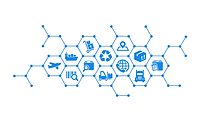
Although the U.S. wind energy industry endured another year without a stable national renewable energy policy in 2010-and in spite of the economic downturn-the industry built 5,116 megawatts (MW) of new capacity, leading to an annual growth of 15%. The total wind turbine fleet now stands at well over 40,000 MW, with over 35,000 wind turbines supplying clean energy to the equivalent of over 10 million homes. Such numbers in the current economic climate are good news for those companies eyeing the industry as they contemplate becoming members of its supply chain.
Despite the fact that there were only 18 months before the expiration of the production tax credit (PTC), which is the primary financial policy for the industry, the wind energy industry continued to grow through the first quarter of 2011, installing 1,100 MW of new capacity. The rebound continued in the second quarter, with 2,151 MW installed in the first half of 2011, vs. 1,250 MW during the same time in 2010 (a 72% increase).
Moreover, an additional 7,354 MW of new capacity was under construction by July 1, more than at any time since the third quarter of 2008. The majority of those megawatts are already locked in under long-term power purchase agreements with electric utilities, indicating an enduring industry that has proven both nimble and strong through a range of economic and policy conditions. With the solid under-construction numbers posted for the first half of the year, industry results for the full year are expected to be strong.
Wind power is a mainstream electricity generation source and has been responsible for 35% of all new electric generating capacity over the last four years-more than coal and nuclear combined. “American wind energy is ramping up,” says Denise Bode, CEO of the American Wind Energy Association (AWEA). “Refined technologies, affordable prices, and continued demand for clean, homegrown energy-these are all reasons why wind has consistently posted strong growth numbers.”
The Drivers
Simply put, wind power is an attractive product, even to customers (e.g., utilities) who are notorious for being late adopters and generally resistant to change. Clean, homegrown wind energy has become increasingly affordable and cost competitive. Electric utilities, knowing a good buy when they see one and anxious to lock in energy costs to provide a hedge against volatile fossil-fuel prices, are entering long-term power purchase agreements for wind power.The uncertainty brought on by the lack of consistent policy at the federal level continues to be a challenge for the industry. However, the absence of consistent policy-the kind enjoyed by all other energy industries-has more or less become a way of life for the wind industry, which has grown nimble in dealing with it. Wind power basically “grew up” (i.e., became a 35% contributor of all new electric generation) in an unstable policy environment, given that the PTC has usually been extended in one- and two-year intervals and has even been allowed to expire before being renewed.
In the absence of consistent federal policy, state policy has become important for the wind industry. Many states are leading the charge on the policy front, and they are reaping the returns in the form of wind energy development and manufacturing growth. An impressive 38 states now have utility-scale wind projects, with 14 states boasting more than 1,000 MW of clean wind power. California’s recently increased 33% renewable electricity standard (RES) is helping to drive a robust West Coast development scene. As previously mentioned, construction numbers are up for the nation as a whole.
Iowa-which passed the first state RES in 1983-now produces 20% of its electricity from wind power. The Hawkeye State, in fact, is a prime example of how the supply chain follows wind farm development action, planting roots near where the projects are located. The state has attracted a significant number of major manufacturers and developers, bringing more than $5 billion of investment to the state and supporting 4,000-5,000 jobs. Iowa is now a national leader in wind power manufacturing, and wind farms online in Iowa power the equivalent of 900,000 homes.
Iowa’s capacity installations are still second to Texas, a state that achieved a major milestone in 2010 when it passed the 10,000-MW threshold. Illinois, South Dakota, and Minnesota all installed between 400 and 700 MW, while Indiana moved into the top-10 bracket for the first time. The Hoosier State also passed a voluntary Clean Energy Portfolio Standard (CPS), which set a goal of 10% of the state’s electric generation to come from clean energy sources by 2025 and incentivizes utilities to participate. Like Iowa, Texas-traditionally known as the oil-and-gas hub of the nation-is also a wind power manufacturing leader.
“During the 112th Congress, we’ll continue to work for predictable federal energy policies to ensure we have a diverse portfolio of energy sources to power a cleaner, stronger America,” Bode says. “We’ll also help to defend and improve upon state renewable targets and promote other sources of demand, such as more distributed and community wind projects. We’ll help developers address their siting and transmission challenges so the industry can reach its full potential. In an economy in which gas prices have hit $4 per gallon and are still on the rise, America must implement long-term energy policies centered on homegrown sources. And wind delivers.”
Evolving Supply Chain
With state policies leading the way (not to mention a history of PTC extensions, albeit often in the 11th hour, at the federal level), the wind energy industry continues to represent a business opportunity for manufacturers, as well as component and commodity suppliers, even in a period of economic malaise and comparatively reduced demand for wind turbines. The U.S. is on schedule for producing 20% wind power by 2030 under the scenario mapped out in the U.S. Department of Energy’s three-year-old report showing the feasibility of achieving that percentage of wind penetration in two decades’ time. An estimated 60,000 turbines will need to be installed between now and 2030 to reach the 20% energy contribution mark. That provides for a lot of opportunity within the supply chain.Equally important to the continued growth in opportunity is the increase in domestic wind turbine and turbine component manufacturing. When the AWEA launched its Supply Chain initiative several years ago, the intent was to grow the supply chain significantly. Between 2005 and 2009, U.S.-deployed wind turbine’s domestic content doubled, from 25 to 50%, even as the overall wind power market quadrupled. The latest numbers are even better: According to a June 2011 report from the U.S. Department of Energy’s Lawrence Berkeley National Laboratory, domestic content has risen to 60%.
Driving that trend, of course, are the wind turbine original equipment manufacturers (OEMs). In 2005, only one OEM assembled turbines in the U.S. By 2010, a total of 10 companies were assembling nacelles here. Moreover, eight additional companies have announced plans to build turbines in the U.S. This high-level activity is driving demand for local supply chains for turbine internals. Today, over 400 companies all across the country produce components for the wind industry.
OEMs say that trend will continue and have expressed their desire to keep expanding their supply chain here. That’s because, unlike with all too many products now produced overseas, the industry’s economics are such that wind power components are best sourced domestically-that is, near the projects. Thus, while the industry’s last record-setting year for megawatt installations came in 2009, the opportunities for supply chain companies continue to expand and diversify.
Even as the wind turbine market sees the usual ebb and flow, domestic content is expected to continue to grow and provide new opportunities for suppliers. That trend was seen just recently, when in 2010, while the industry had a slower year for projects than in the previous year, U.S. plants continued to enter the industry supply chain.
In response to this ever-shifting landscape, the AWEA is now switching gears, so to speak, in its supply chain initiative and focusing on consolidating the gains made over the past few years and continuing to grow domestic manufacturing and the attendant jobs based here in the U.S. Many challenges remain, especially for some components that continue to be imported in large quantities; the association is starting to narrow its focus on such components.
For more information, visit www.awea.org.

